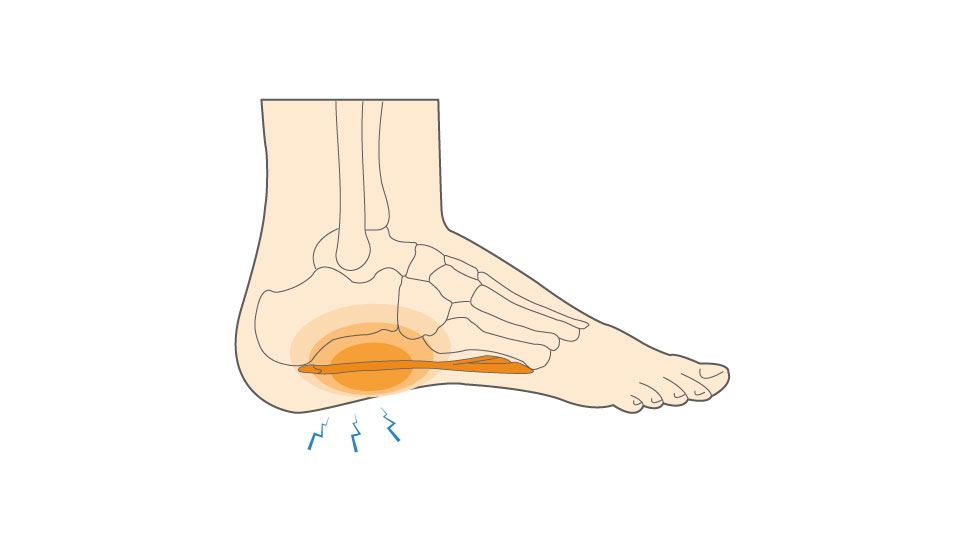Plantar fasciitis is inflammation of the plantar fascia ligament on the bottom of the foot. The plantar fascia is an essential ligament that connects the heel with each of the toes and gives support to the arch. When the plantar fascia becomes irritated or damaged, it can lead to foot inflammation, called plantar fasciitis. Inflammation can cause pain, making walking and participating in athletic activities difficult.
Plantar Fasciitis Causes, Symptoms & Treatment Options
Plantar fasciitis is foot inflammation caused by the plantar fascia, a thick band of tissue that runs along the bottom of your foot. This crucial ligament connects your heel to your toes and plays a key role in supporting the arch of your foot. When the plantar fascia becomes strained, irritated, or damaged, it can lead to inflammation and pain, a condition known as plantar fasciitis.
Overview
Overview

What causes Plantar Fasciitis?
The plantar fascia acts as a shock absorber for the impact, strain, and stress we put on our feet daily. This pressure is exaggerated for athletes, as the impact of running and jumping greatly stresses the ligament. When too much strain is placed on the plantar fascia, small tears can develop that become inflamed and cause heel pain. Athletes with the following risk factors are more likely to develop plantar fasciitis:
• Tight Achilles tendon
• Tight calf muscle
• Wearing shoes that don’t provide enough arch support
Plantar fasciitis is most common in these sports:
• Baseball
• Basketball
• Football
• Running
• Soccer
• Lacrosse
Symptoms
Plantar fasciitis generally presents itself as pain on the bottom of the heel. It may be sharp at times and a dull ache at other times. Heel pain is most commonly felt when:
• You might experience morning foot pain when taking your first steps.
• Getting up from a seated position
• Performing extended weight-bearing activities
Sometimes, you may feel pain in the arch, although this is less common.
When to see a doctor
If you’re experiencing mild to moderate pain in the heel that does not resolve after a few weeks, make an appointment to see an orthopedic specialist. During the appointment, you’ll be asked to describe your pain. Your doctor will then examine your foot for tenderness and to rule out other possible causes of heel pain, such as a stress fracture or nerve entrapment syndrome. You may also need to get an x-ray to look for bone spurs. Very rarely, a magnetic resonance imaging (MRI) scan may be needed to confirm the diagnosis.
Non-operative treatment
Roughly 98.5% of cases of plantar fasciitis resolve with conservative care. Conservative plantar fasciitis treatment options include:
• Silicone heel wedges, soft arches, and possibly custom • orthotics (a type of shoe insert) to provide more support to the foot
• Modifying activities until symptoms improve
• Achilles tendon stretching
• Plantar fascia stretching
Severe cases of plantar fasciitis may require immobilization and physical therapy. If your symptoms persist for several months, your doctor may recommend a cortisone injection to help relieve foot inflammation and heel pain.
Try these exercises to help address your condition:
Below is a PDF of the Exercise Program
Surgical Treatment
In rare cases, plantar fasciitis may require surgical intervention to relieve symptoms. You may need surgery if your symptoms persist for six to 12 months while doing conservative treatment. There are two surgeries that are used for plantar fasciitis treatment. Each procedure can be performed arthroscopically (through a tiny incision) or using an open technique (through a larger incision). These procedures are:
• Plantar fascia release: A small part of the fascia is cut to release tension and therefore relieve symptoms.
• Gastrocnemius recession: A small cut is made in the gastrocnemius tendon, loosening and lengthening the muscle in order to release tension in the plantar fascia.
Recovery
Since plantar fasciitis treatment is usually conservative, you can quickly return to play. However, symptoms can sometimes last for months, even with appropriate conservative treatment.
If you have surgery for plantar fasciitis, recovery time will depend on whether you had open or arthroscopic surgery. Following an open plantar fascia release or gastrocnemius recession procedure, you will be required to wear a protective brace or boot for two to three weeks. Recovery will involve physical therapy, but you will not be allowed to run or jump for at least three months following the procedure. Before you can return to full athletic activities, your doctor will expect you to have regained full range of motion and strength without any pain.
GET BACK TO WHAT YOU LOVE. FASTER
Sources
https://orthoinfo.aaos.org/en/diseases–conditions/plantar-fasciitis-and-bone-spurs
http://www.aofas.org/footcaremd/conditions/ailments-of-the-heel/Pages/Plantar-Fasciitis.aspx
https://www.mayoclinic.org/diseases-conditions/plantar-fasciitis/symptoms-causes/syc-20354846
http://www.aofas.org/footcaremd/treatments/Pages/Plantar-Fascia-Release.aspx
https://wa.kaiserpermanente.org/kbase/topic.jhtml?docId=hw114401
http://www.aofas.org/footcaremd/treatments/Pages/Gastrocnemius-Release-(Strayer-Procedure)-.aspx
Frequently Asked Questions
Which exercises should be avoided with plantar fasciitis?
Avoiding high-impact exercises, such as running or jumping, is best when dealing with plantar fasciitis. Without proper warm-ups, these activities strain your feet and ankles, leading to tight muscles and further injuries.
Can plantar fasciitis heal quickly?
It’s essential to rest and perform exercises to stretch your plantar fascia. Recovery can take a while. It may take several months or even up to a year for the pain to subside entirely.
What’s the best way to relieve plantar fasciitis pain?
One simple technique is to roll a soft-spiked plastic ball under your foot, which can be a massage. You may also be prescribed nonsteroidal anti-inflammatory drugs (NSAIDs), like naproxen or ibuprofen. These drugs will help reduce pain and inflammation over a 10—to 14-day period.
How is plantar fasciitis treated?
Most cases improve with stretching exercises, orthotics, activity modification, and sometimes physical therapy or injections.

